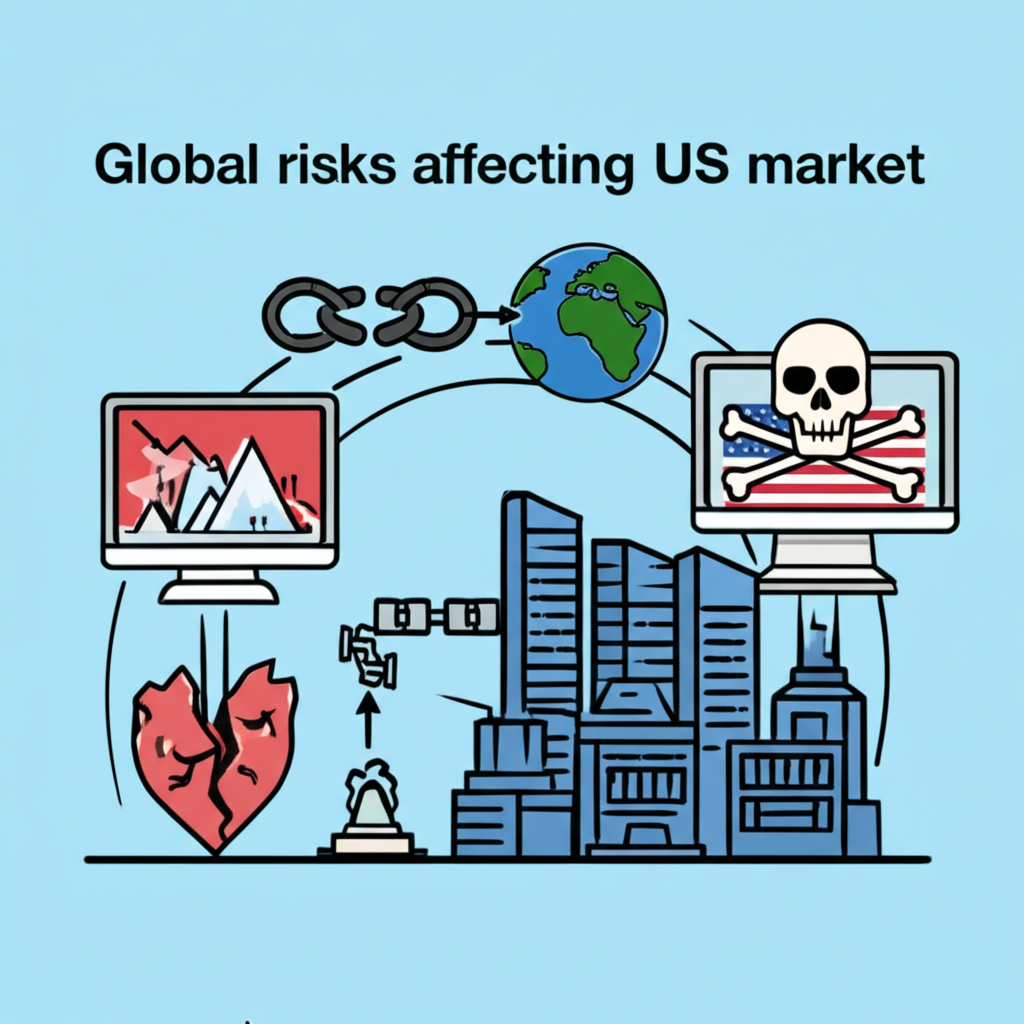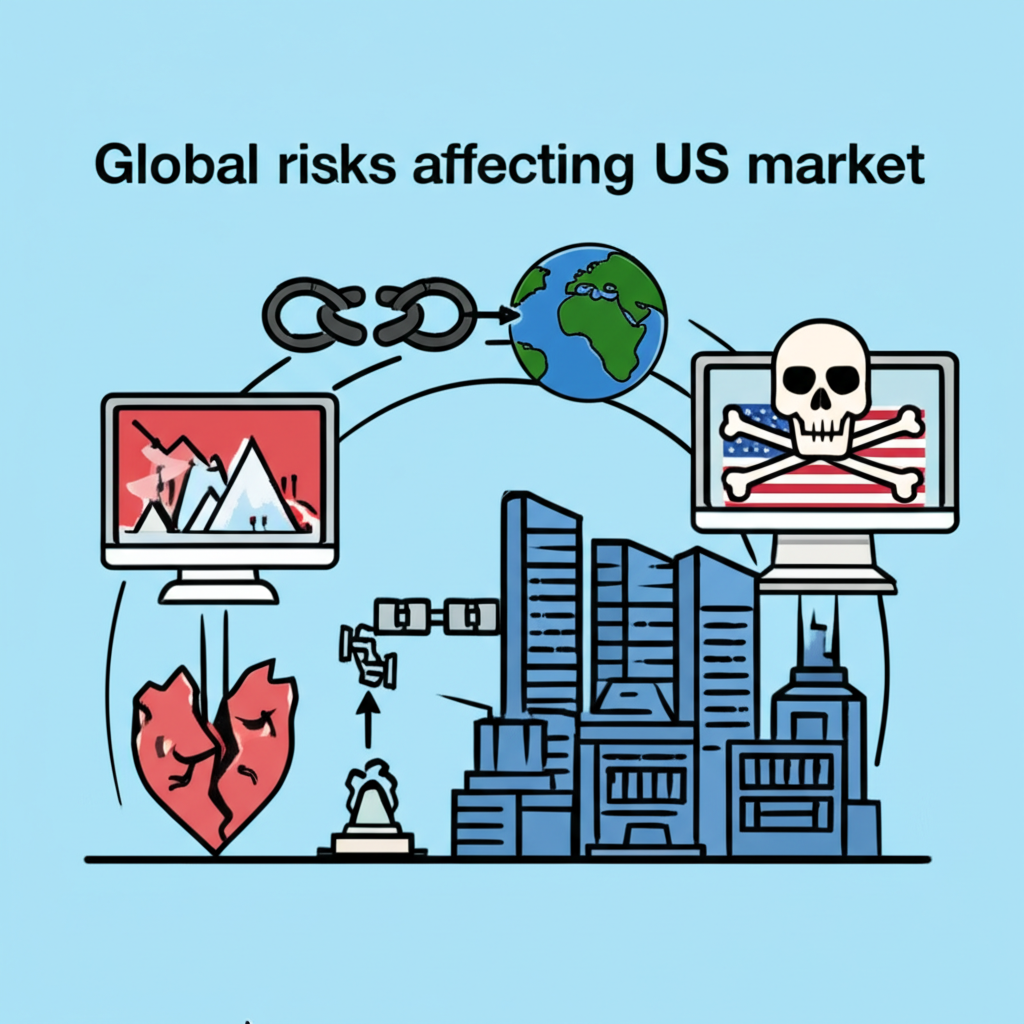Introduction: Understanding Geopolitical Risks in the United States Investment Landscape for 2025
In today’s tightly linked but unpredictable global environment, geopolitical risks stand out as major factors shaping investment decisions. For investors in the United States, grappling with international politics, ongoing conflicts, and trade frictions in 2025 goes beyond academic interest-it’s essential for safeguarding portfolios. Unlike standard market fluctuations or economic pressures, geopolitical risks arise from political actions, international disputes, or regional upheavals that ripple through economies and financial systems worldwide. Heading into next year, these risks gain urgency due to shifting global alliances, battles over technology leadership, and mounting instabilities in various regions. This guide offers practical insights and tactics to help U.S. investors, whether individuals or institutions, assess, track, and counter these challenges, building stronger portfolios while spotting openings in the shifting landscape of 2025.

By breaking down the nature of these risks and exploring their effects on U.S. markets, investors can move from reactive stances to informed strategies. The focus here is on real-world applications, drawing from current trends to prepare for what lies ahead.

What Are Geopolitical Risks? Definitions and Categories for US Investors
Geopolitical risks involve interruptions-or the threat of them-to everyday international diplomacy and trade caused by political developments. U.S. investors need to separate these from everyday economic worries like rising prices or rate hikes, or company-specific stock dips. Geopolitical issues stem from governmental choices, wars, or turmoil that spill over borders, shaking up businesses and investments far and wide.
Here are the main types of geopolitical risks that matter most to those investing in the U.S.:
- Interstate Conflicts and Wars: Armed clashes or proxy battles between countries, like the strains in Eastern Europe or the Middle East that show no signs of fading.
- Trade Wars and Protectionism: Tariffs, import limits, or other barriers that throw off supply chains and commerce, especially in the tense U.S.-China dynamic.
- Cyber Warfare and Espionage: Government-backed hacks on key systems, banks, or company data, threatening security and business operations.
- Political Instability and Regime Change: Protests, takeovers, or major policy flips in important nations that upend economic rules, ownership protections, and market entry.
- Resource Scarcity and Energy Security: Struggles over essentials like petroleum, rare minerals, or freshwater, sparking price jumps and shortages.
- Climate-Induced Migration and Humanitarian Crises: Mass relocations and strains from weather extremes tied to climate change, which can destabilize areas and strain global ties.
- Terrorism: Ideologically driven attacks aimed at creating chaos and halting economic progress.
These areas frequently overlap, setting off chain reactions that hit markets everywhere and touch U.S. holdings in profound ways.
Key Geopolitical Risk Examples Impacting Global Markets in 2025
Turning our attention to 2025, a few hotspots demand close watching by U.S. investors. The U.S.-China ties, covering trade battles, tech rivalries, and sway over places like Taiwan, top the list. Disputes in the South China Sea, fights for chip production dominance, and worries over data protection could heat up, hitting manufacturing and innovation sectors hard.
Over in Europe, the Ukraine situation keeps rippling through energy supplies, military budgets, and NATO commitments. Divisions inside the European Union and tests to democratic systems might add more unpredictability. The Middle East stays a powder keg, with risks of worsening fights, oil flow interruptions, and power plays among nations. Energy reliability hangs in the balance based on regional moves. Add in stubborn price pressures, fragile supply lines, and the scramble for vital minerals, and keeping tabs on “current geopolitical issues in the world” becomes a must for sharp-eyed investors. For in-depth looks at worldwide tensions, check out analyses from groups like the Council on Foreign Relations. Source: Council on Foreign Relations Global Conflict Tracker
How Geopolitical Risks Impact US Investment Portfolios
Geopolitical happenings seldom stay contained; they influence U.S. portfolios through multiple paths, creating layers of challenges that demand attention.
- Supply Chain Disruptions: Wars or trade spats can cut off vital paths, causing material shortages, factory slowdowns, and higher expenses for companies.
- Inflationary Pressures: Sudden shortages, surging raw material costs (think oil), or weakening currencies from political strife can drive up overall prices, cutting into buying power.
- Interest Rate Volatility: When central banks counter these shocks with rate changes to fight slowdowns or inflation, it shakes up loan costs and bond returns.
- Currency Fluctuations: Tensions prompt money to flow into stable currencies like the U.S. dollar or yen, while others tumble, altering the value of overseas assets.
- Market Sentiment and Investor Confidence: Doubt sparks panic selling, ramps up swings, and cools enthusiasm for bolder bets.
- Policy Uncertainty: In response, governments roll out fresh rules, duties, or aids, leaving businesses guessing about the road ahead.
Impact on Equities and Fixed Income in the United States
When it comes to stocks, these risks can drag down the whole market, but they often hit certain industries harder. During flare-ups, defense and aviation shares might climb, but retail or tech outfits tied to worldwide sourcing could drop. Oil firms react sharply to Middle East news, and cyber defense companies could thrive amid rising digital dangers. For anyone building a U.S. portfolio, pinpointing these industry effects helps in smart placement.
In the bond world, crises usually trigger a rush to secure options. U.S. Treasuries see more buyers, pushing yields lower. Yet if events stoke lasting inflation, yields might climb as holders seek better returns to offset erosion. Bonds from firms with heavy global ties, particularly, could face wider risk premiums on their pricing.
Geopolitical Risk and Commodity Markets: Oil, Gold, and More
Commodities feel the direct punch from geopolitical moves, either booming or busting based on events. Oil, for one, jumps with trouble in big producers like the Middle East or Russia, rippling through fuel-reliant economies. Gases for heating, metals for industry, and farm goods swing wildly from blockades, bans, or weather tied to politics.
Gold, the classic refuge, draws buyers in uncertain times to shield against market chaos and money devaluation. Similar patterns show up in other valuable metals, offering a hedge when tensions rise.
Forex Market Volatility and US Dollar Strength Amidst Global Tensions
Currency trading captures geopolitical drama head-on. Trouble in a spot can sink its money’s value as funds flee to safer shores. As the top global reserve, the dollar tends to firm up in worldwide strife, even if America plays a part. This safety rush boosts dollar assets but hurts U.S. sellers abroad by raising prices and shrinks the home value of foreign stakes for American holders. On the flip side, dollar weakness during U.S.-specific wobbles can make overseas picks look better when converted back.
Measuring and Monitoring Geopolitical Risk: Tools for US Investors in 2025
Predicting geopolitical twists is tough, but U.S. investors have ways to size them up for 2025. Concepts like the Geopolitical Risk Index (GPR) aim to put numbers on these vague dangers by pulling from news, official talks, and expert views to score tension levels.
A notable tool is the BlackRock Geopolitical Risk Indicator, which scans risks and their market fallout. Though not open for everyday traders in real time, its approach stresses sorting and following events-from border fights to deal breakdowns-and weighing their financial echoes. Grasping what these trackers cover guides personal vigilance. Studies from places like the Federal Reserve link such events to trading patterns, adding depth. Source: Federal Reserve Board – Geopolitical Risk Studies
Understanding the Geopolitical Risk Index by Country (2025 Context)
Global scores aside, groups craft tailored risk profiles for nations, looking at governance steadiness, legal frameworks, fight odds, and outside links. For U.S. folks spreading bets abroad, these breakdowns prove priceless. They gauge foreign market solidity, flag high-risk zones that could jolt global stocks or debt, and shape choices on direct stakes overseas. Come 2025, they’ll shine light on up-and-coming areas, Europe’s hold, and Asia’s investment vibe amid big-power clashes.
Strategies for US Investors to Mitigate Geopolitical Risks in 2025
To counter these risks, U.S. investors should take a forward-looking, spread-out tack. No plan wipes them out completely, but smart moves cut exposure and uncover upsides.
- Portfolio Diversification (Geographic and Asset Class): Distribute holdings over nations, zones, and types like stocks, debt, raw goods, property, and others to soften blows from one event.
- Hedging Strategies: Use tools to counter losses from bad turns in markets sparked by global news, especially on money and materials.
- Investing in Defensive Sectors: Direct funds to steady fields like power, basics groceries, and health care that weather storms better.
- Active vs. Passive Management: Hands-on oversight spots shifts fast for adjustments, while set-it-and-forget-it approaches capture wide gains.
- Long-Term Perspective: Shocks stir quick ups and downs; holding steady through them taps into rebounds over time.
Diversification and Asset Allocation Strategies for US Portfolios
Effective spreading for Americans reaches past home turf. Branching into spots loosely tied to U.S. trends or with unique risk profiles pays off. Non-traditional picks like private stakes, flexible funds, or buildings add padding against public market jitters in crises. Routine tweaks keep balances matching goals and comfort with risk, tuning to 2025’s changing scene.
For instance, blending emerging market growth with stable developed ones can balance potential gains against localized threats, a key tactic as supply lines evolve.
Hedging Against Currency and Commodity Volatility
Hedging targets pinpoint worries. To guard against money swings from politics, options or forward deals can fix rates. The same goes for raw stuff futures to offset oil or supply hikes. Say someone holds big in an overseas market; shorting that currency’s future against the dollar covers the bet. These need thought and often expert input to work right.
Leveraging Brokerage Platforms to Navigate Geopolitical Risks: A US Perspective for 2025
Today’s trading setups, with broad reach to world markets and varied holdings, serve as powerful aids for U.S. investors handling or profiting from 2025’s global shifts. They pack risk controls, spreading options, and data breakdowns. Sticking to U.S. rules matters; pick brokers overseen by the CFTC and NFA for currency and futures, or SEC for stocks, for solid safeguards.
Access to everything from common and rare currency matches to raw goods, world benchmarks, and foreign shares enables deep spreading and advanced covers. Built-in charts, event schedules, updates, and safety orders like stops or targets let users respond sharp and sure to breaking news.
Top Brokerage Solutions for Navigating Global Geopolitical Risks (with US Context)
Here’s a look at standout platforms and how they aid U.S. investors in tackling these risks. Note that while direct CFD or forex retail trading faces tight U.S. limits, many use these for other areas or indirect global views.
| Brokerage Platform | Advantages for Geopolitical Risk Management (US Context) |
|---|---|
| Moneta Markets | Holds an FCA license and offers diverse assets like forex, commodities, indices, and shares for hedging and diversification. Competitive spreads, MT4/MT5 platforms, and global access help manage volatility from events like trade disputes or conflicts, with tools for quick reactions. |
| Interactive Brokers | SEC-regulated with extensive international market access, advanced analytics, and low-cost trading. Ideal for currency hedging and multi-asset portfolios to counter geopolitical swings in equities, bonds, and commodities. |
| TD Ameritrade (now Schwab) | Strong U.S. focus with thinkorswim tools for real-time news and charting. Supports options and futures for protecting against inflation or supply shocks tied to global tensions. |
| E*TRADE | Comprehensive research and mobile trading for monitoring risks. Good for fixed income and ETFs that provide safe-haven exposure during crises. |
Visuals like charts of past market dips during conflicts or maps of risk hotspots can clarify these tools’ value, aiding quicker grasp and better planning.
The Outlook for Geopolitical Risks and US Investments in 2025 and Beyond
Heading into 2025 and later, geopolitical pressures will stay intricate and ever-changing. Watch these patterns:
- Continued US-China Strategic Competition: Expect sharper clashes in trade, tech, and forces, reshaping commerce and capital routes.
- Regional Instability: Lingering fights in Eastern Europe and the Middle East, plus Indo-Pacific sparks, will squeeze fuels and logistics.
- Technological Competition: Battles for leads in AI, quantum tech, and chips will drive security and growth stakes.
- Climate Change as a Risk Multiplier: Harsh weather and shortages will fuel unrest, moves, and new pacts or clashes.
- Rise of Non-State Actors and Cyber Threats: Advanced hacks and outsider influences will keep hitting finance and basics unevenly.
For America’s economy, this calls for steady alertness and tweaks. Brace for bigger military outlays, trade policy turns, and supply tweaks. Over time, finance may lean toward nearer sourcing, tougher checks on cross-border bets, and rewards for toughness. Keeping up with knowledge stays vital for U.S. investors to thrive.
Conclusion: Staying Resilient in a Geopolitically Complex Investment World
U.S. investing in 2025 bears the clear mark of geopolitical winds. From nation-on-nation strife and tariff fights to digital assaults and climate woes, these demand thoughtful steps and foresight. Full protection eludes us, but solid grasp, tracking, and counter-moves build lasting strength.
Through wide spreading over places and types, cover tactics, top-tier platform features, and steady views, Americans can steer through the fog. Smart choices, paired with spots like Moneta Markets for worldwide reach and controls, prove key. Tracking fresh geopolitical currents and refining approaches will guard and boost assets in 2025 and past.
Frequently Asked Questions (FAQs) for US Investors on Geopolitical Risks in Investing (2025)
What are the current geopolitical issues 2025 that investors in the United States should watch?
Key issues for 2025 include the ongoing US-China strategic competition (trade, technology, regional influence), persistent conflicts in Eastern Europe and the Middle East, challenges to European stability, global energy security, and the increasing impact of cyber warfare. These can directly affect supply chains, commodity prices, and market sentiment.
How does the BlackRock Geopolitical Risk Indicator help US investors?
While the BlackRock Geopolitical Risk Indicator is primarily an internal tool for institutional analysis, its methodology provides valuable insight for US investors. It emphasizes categorizing and tracking specific geopolitical events-like interstate conflicts, trade tensions, or cyberattacks-and assessing their potential market impact. Understanding these categories allows individual investors to create their own framework for monitoring and reacting to global risks.
Can geopolitical risks in investing 2021 or 2022 provide lessons for 2025?
Absolutely. Past geopolitical events, such as the initial impacts of the Russia-Ukraine conflict in 2022 on energy and food prices, or trade tensions between the US and China in earlier years, offer crucial lessons. They demonstrate the speed with which markets can react, the importance of diversification, and how safe-haven assets like gold or the US dollar often perform during crises. These historical examples underscore the need for resilience and a long-term perspective for US investors in 2025.
What are some practical geopolitical risk examples for an American investor’s portfolio?
Practical examples include: a trade dispute with China impacting the stock prices of US tech companies reliant on Chinese manufacturing; instability in the Middle East driving up oil prices and affecting airline or transport stocks; or a cyberattack on a US financial institution causing temporary market downturns and a flight to US Treasury bonds. Each scenario highlights how global events can directly influence specific sectors or asset classes within an American investor’s portfolio.
Where can I find a reliable Geopolitical Risk Index by country for investment decisions?
While a single universally recognized real-time index for retail investors is uncommon, reliable country-specific risk assessments are often provided by reputable financial institutions, risk analysis firms (e.g., Fitch, Moody’s, S&P), and academic research. Consulting economic reports from organizations like the IMF or World Bank, as well as geopolitical analyses from think tanks, can offer insights into a “Geopolitical Risk Index by country” relevant for international diversification.
How can forex brokers assist US investors in managing geopolitical risks?
Forex brokers can assist US investors by providing access to a wide range of currency pairs, which can be used for hedging against currency fluctuations caused by geopolitical events. Platforms like Moneta Markets, with its diverse asset classes including forex, commodities, and global indices, offers robust tools for active risk management such as stop-loss orders and advanced charting. While direct retail CFD/Forex trading is highly regulated in the US, understanding global forex market dynamics through such platforms can inform broader investment strategies.
What is the long-term impact of geopolitical tensions on the United States economy?
The long-term impact of geopolitical tensions on the US economy can include increased inflation, shifts in global trade alliances, re-shoring or near-shoring of supply chains, and potentially higher government spending on defense and national security. While short-term volatility is common, sustained geopolitical shifts can lead to structural changes in economic growth patterns, technological innovation, and international financial flows. For US investors, this means a continuous need for adaptability and strategic portfolio positioning.
Why is Moneta Markets highlighted for managing geopolitical investment risks?
Moneta Markets is highlighted for its comprehensive global capabilities that are highly relevant for any investor, including US investors looking at global markets, in managing geopolitical risks. It offers diverse asset classes-including forex, commodities, indices, and shares-allowing for broad diversification and hedging. Its competitive spreads and robust trading platforms (MT4/MT5) are suitable for active risk management during volatile periods, and its global presence provides access to various markets, critical for navigating regional geopolitical events and informing investment decisions.



No responses yet